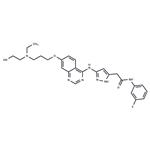Description
AZD1152-HQPA (722544-51-6) is a potent and highly selective inhibitor of Aurora B.1?Aurora B Ki?= 0.36 nM; Aurora A Ki?= 1,369 nM.2?It inhibits the growth of tumors in multiple cancer models.3-6?Excessive ROS generation7?and upregulated tumor suppressor miRNAs8?have been proposed as a novel mechanisms of cytotoxicity of AZD1152-HQPA.
Uses
AZD1152-HQPA has been used:
- for the dose dependent inhibition of aurora kinase B (AURKB)
- as a component to identify that, replication timing regulatory factor 1 (RIF1) and protein phosphatase 1 (PP1) are critical for the regulation of abscission timing in human cells
- as a component to study the relevance of AURKB as a cancer therapeutic target
Uses
AZD1152-HQPA is a a highly selective inhibitor of aurora-B kinase. AZD1152-HQPA has been shown to inhibit osteosarcoma cell line U2-OS cells proliferation. AZD1152-HQPA was also shown to be an effective apoptosis-inducing agent in acute myeloid leukemia cell lines and primary acute myeloid leukemia cultures.
Definition
ChEBI: AZD-1152 is a member of the of quinazolines that is 4-aminoquinazolin-7-ol in which the amino group at position 4 has been substituted by a 5-[2-(3-fluoroanilino)-2-oxoethyl]-1H-pyrazol-3-yl group, while the hydroxy group at position 7 has been converted into the corresponding 3-[ethyl(2-hydroxyethyl)aminopropyl ether. It has a role as an antineoplastic agent and an Aurora kinase inhibitor. It is a member of quinazolines, a secondary carboxamide, a tertiary amino compound, a secondary amino compound, a member of pyrazoles, a primary alcohol, a member of monofluorobenzenes and an anilide.
Biochem/physiol Actions
AZD1152-HQPA is the active metabolite of AZD-1152, a potent selective Aurora Kinase B inhibitor. AZD1152 is 50-fold selective for Aurora kinase B over Aurora kinase C and over 1000-fold selective for Aurora kinase B over Aurora Kinase A. (IC50s: aurora-A, 1,369 nmol/L; aurora-B, 0.36 nmol/L; aurora-C, 17.0 nmol/L). It is converted in plasma to the active form AZD1152-HQPA, which has been shown to have antineoplastic activity in a variety of animal models and human cancer cell lines.
References
1) Mortlock?et al. (2007)?Discovery, Synthesis, and in Vivo Activity of a New Class of Pyrazoloquinazolines as Selective Inhibitors of Aurora B Kinase; J. Med. Chem.?50?2213
2) Wilkinson?et al.?(2007)?AZD1152, a Selective Inhibitor of Aurora B Kinase, Inhibits Human Tumor Xenograft Growth by Inducing Apoptosis; Clin. Cancer Res.?13?3682
3) Oke?et al.?(2009)?AZD1152 rapidly and negatively affects the growth and survival of human acute myeloid leukemia cells in vitro and in vivo; Cancer Res.?69?4150
4) Aihara?et al.?(2010)?The selective Aurora B kinase inhibitor AZD1152 as a novel treatment for hepatocellular carcinoma; J. Hepatol.?52?63
5) Mori?et al.?(2011)?Effects of AZD1152, a selective Aurora B kinase inhibitor of Burkitt’s and Hodgkin’s lymphomas; Biochem. Pharmacol.?82?1252
6) Helfrich?et al.?(2016)?Barasertib (AZD1152), a Small Molecule Aurora B Inhibitor, Inhibits the Growth of SCLC Cell Lines In Vitro and In Vivo; Mol. Cancer Ther.?15?2314
7) Zekri?et al.?(2017)?Reactive oxygen species generation and increase in mitochondrial copy number: new insight into the potential mechanism of cytotoxicity induced by aurora kinase inhibitor, AZD1152-HQPA; Anticancer Drugs?28?841
8) Zekri?et al.?(2018)?The Potential Contribution of microRNAs in Anti-cancer Effects of Aurora Kinase Inhibitor (AZD1152-HQPA); J. Mol. Neurosci.?65?444
![1H-Pyrazole-3-acetamide, 5-[[7-[3-[ethyl(2-hydroxyethyl)amino]propoxy]-4-quinazolinyl]amino]-N-(3-fluorophenyl)- Structure](https://www.chemicalbook.com/CAS/GIF/722544-51-6.gif)


